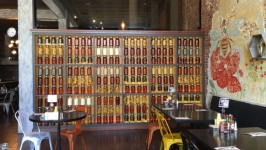Bee City
A crowd surrounds a man with a butterfly net, anxious to get a glimpse of his catch. He takes a plastic cup and scoops it into the mesh, retrieving a sweat bee, a solitary pollinator harvesting pollen and nectar to feed its young. As the crowd swarms in to get a closeup view, the insect buzzes around its container. The volunteer turns from the crowd and releases the imprisoned sweat bee, which zips away to a nearby flower to continue its errands.
This spectacle is just one of several you can find at the yearly Pollinator Celebration hosted by Bee City USA’s chapter in Garden City. The celebration is an opportunity for beekeepers, scientists, gardeners, conservation groups and more to team up and showcase the importance of our local pollinators. And it’s days like today that put a smile on the face of every member of the Bee City Garden City (BCGC) committee.
Bee City USA is a nationwide organization dedicated to teaching urbanites about the importance of pollinators. Garden City, Idaho, was the 13th city in the United States certified as a Bee City USA location, in 2016, and the first in the state of Idaho. The Bee City USA network puts Garden City on the map of municipalities that prioritize pollinators by working with city government to include bee-friendly space in the urban landscape and creating education opportunities for all ages.
Unlike most Bee Cities, the Garden City chapter is managed solely by concerned volunteers, led by Judy Snow, who formed the committee through her work at the Chinden Gardeners Club. Since the group’s start four years ago, the committee has grown to include gardeners, beekeepers and public officials who have dedicated hundreds of hours to the Bee City USA initiatives.
The hard work of the BCGC team is evident in their biggest undertaking yet: the Garden City Pollinator Garden. The volunteers invested several months into creating a pollinator safe haven beside the Boise River. Not only does this garden provide pollinators with food, water and shelter, but it is an interactive educational tool that can be accessed by the community at any time. Each plant is carefully labeled to encourage people to plant the same species at their own homes. Several bee hotels are on the site, with observation windows installed to show how solitary bee species live in the small tubes.
The group reports that before the pollinator garden, it was a decrepit lot. For months, the team repaired the soil and pulled weeds; after two years, the lot had been shaped into a pollinator paradise.
“There is nothing scarier than a bug-free property,” says Judy. “But in a short time, we had an amazing diversity of beetles, hummingbirds, bumblebees… Just goes to show, if you plant it, they’ll find it.”
The pollinator garden is now in its third year. The plants have grown strong and healthy and continue to flourish under the careful watch of the Bee City volunteer team that tirelessly weeds the garden and maintains the walking paths.
“I love the work days, working as a team in the garden. It really feels like being part of a community,” says Bee City committee member Robyn Dawson.
When the volunteers aren’t hard at work in the pollinator garden, they focus on public education events. BCGC hosts a lecture series in which experts present on conservation and protection of the thousands of species of pollinators, including wasps, bumblebees and flies. The educational efforts cumulate into the yearly Pollinator Celebration, which features tours of the completed Pollinator Garden.
The Bee City Garden City team says that their efforts are only the start. Citizen awareness and action are what make the volunteers’ efforts worthwhile. Good Samaritans who pull weeds rather than spraying, who plant pollinator-friendly yards, are the backbone of the BCGC’s success in the city.
“We need lots and lots of people to plant flowers and stop using pesticides to save our pollinator populations,” says Judy. “Our yards are an incredible resource for pollinators.”
Garden City Council Member Jeff Souza says volunteer work is critical for the success of the group’s initiatives. His hope is to see more citizens create their own pollinator gardens and take ownership of their green spaces. “There’s plenty of spaces for these pollinator gardens, and volunteers can expand on that.” he says. The BCGC is always looking for more volunteers, and there is a job for any kind of interest, from gardening to public speaking to online outreach.
One of the best ways the community can help the pollinators is to make pollinator habitat a priority in home gardening as well as urban planning. Talking to homeowner associations and developers to emphasize a need for green spaces and pollinator habitat is very impactful. But Bee City reminds everyone that there is no act too small in the fight to save pollinators.
“Even if you’re in an apartment and you can only add a pot of flowers on your patio,” says committee member Debbie Courson Smith, “every little bit helps.”
Bee City USA | @beecityusa
Bee City Garden City | @beecitygardencity
Chinden Gardeners Club







